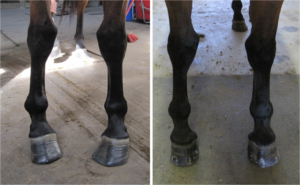Responsible Horse Care

Crooked legs are genetically inherited. Though a farrier may accommodate horses with crooked legs with good trimming or shoes that can make them more comfortable, it’s important for horse owners to understand the farrier isn’t “fixing” it.
We all want to help our horses to be comfortable and sound. As horse owners, farriers and veterinarians it is worth considering some things we have control over (nutrition, exercise, regular trimming and shoeing intervals) and things we have no control over (genetics, congenital defects). It is important that we recognize the things we have little or no control over (and to accept it) and to take responsibility for the things we do have control over that can have a positive influence on the horse.
Some things we have no control over
Foot and limb conformations are estimated to have .65 heritability. This means that 65 percent of conformation’s cause is due to heredity or genetics and 35 percent is due to environment or management. Some people wrongly get the idea that we can “fix” these conformational defects. It is true that we can have some influence on straightening young foals’ deviated feet or limbs by applying glue-on extensions. However, the best time to positively affect conformation is when the stallion is introduced to the mare. Conformation is passed on through breeding. Though we may accommodate horses with these problems with good trimming or shoes that can make them more comfortable, it’s important for horse owners to understand we aren’t “fixing” it.
Another factor we have no control over is age. As horses get older, they tend to get stiffer and arthritic (like people!). While trimming or shoeing horses like this, it is best to exercise patience and hold the legs low to where it is comfortable for the horse.
Some things we do have control over
There are things we can control to positively influence our horses. One of these critical factors is feeding. What we feed our horses as well as how much is very important. Often times, horses are owned by people who have no experience in caring for them. In an effort to show love or to produce a larger horse, these people tend to over-supplement and over-feed. Even though they mean well, these people can actually cripple the horse. Horses need to eat 1.5 to 2 percent of their body weight per day (depending on their use). This means that a 1000 pound animal would need about 15 pounds of feed per day (7.5 pounds per feeding if fed twice a day). That covers quantity of feed but quality is also important. 15 pounds of grass hay would have a different effect on the horse than 15 pounds of corn! The required protein and energy in the feed will vary with age, reproductive condition and athletic use. By controlling how much we feed our horses or allow them to eat on pasture we can prevent serious diseases like developmental orthopedic disease (DOD) and laminitis or founder.
Another thing we must take responsibility for is regular intervals for foot care. Most horses should have their feet trimmed every 6 to 8 weeks. Some horses may need shoes depending on the quality of their feet or to keep them comfortable if they have deviations in the limb or conditions like navicular syndrome. Keeping horses’ feet maintained makes for happier horses.
As horsemen and horsewomen, we should learn all we can about horses so we can recognize conditions that we may have little or no control over and take responsibility for the things we do have control over.
Related Posts
-
Often farriers are asked about the rings on the horse’s fo...Jun 14, 2019 / 0 comments
-
We all want to help our horses to be comfortable and sound. ...May 09, 2019 / 0 comments
-
By Doug Butler PhD, CJF, FWCF Lee Liles passed away May 12, ...May 17, 2018 / 0 comments
Blog Categories
- Anatomy
- Best Business Practices
- Conformation
- Current Events
- Customer Service
- Draft Horse Shoeing
- Equine Soundness
- Essential Anatomy Kit
- Farrier Careers
- Farrier training
- Foal soundness
- Horse Care
- Horse Foot Care
- Horse Owner Tips
- Horsemanship
- Horseshoeing
- Horseshoeing History
- Iron and Forge Work
- Student Spotlight
- Uncategorized
- Veterinary Care
Blog Archives
Contact Us
Butler Professional Horseshoeing School
495 Table Road
Crawford, NE 69339
(800) 728-3826
jacob@dougbutler.com
Subscribe to Our Blog
Get Our Free e-Book!
If you think you want to become a farrier (or know someone who does), this book can help you make that decision. Horse owners will learn the importance of choosing a qualified farrier and how to select the “right” one.
[ Get the e-Book Now! ]
- Follow:
